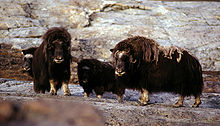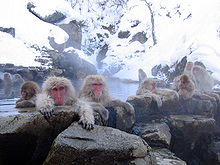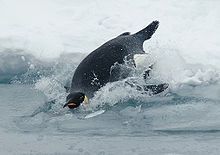- Chionophile
-
Animals that can thrive in cold winter conditions are called chionophiles ("from the Greek chion meaning snow, and -phile meaning lover"). These animals have specialized adaptations that help them survive the harshest winters.
Contents
Polar regions
Arctic animals
Animals such as caribou, arctic hares, arctic ground squirrels, snowy owls, puffins, tundra swan, snow goose, steller's eider and willow ptarmigan all survive the harsh Arctic winters quite easily and some, like the willow ptarmigan, are only found in the Arctic region.
 The musk ox thrived during the ice age 10,000 years ago, but after the earth had warmed up and the ice had receded it was forced to either migrate northward to cold environments for it to live in, or go extinct as the woolly mammoth did.
The musk ox thrived during the ice age 10,000 years ago, but after the earth had warmed up and the ice had receded it was forced to either migrate northward to cold environments for it to live in, or go extinct as the woolly mammoth did.
Antarctic animals
Antarctica, also known as the southern pole is larger and can become much colder then the northern pole. As a result few animals can survive on the mainland of Antarctica, and those that do mostly live near the coast. The few animals that live on the mainland are birds such as Antarctic terns, grey-headed albatross, imperial shag, snowy sheathbill and the most well known inhabitant of Antarctica, penguins. The inhospitable environment helps to deter predators; the few predators that hunt on the mainland, including the south polar skua and the southern giant petrel, mainly prey upon chicks. Most antarctic predators are found in the polar waters, including the orca and the leopard seal.
Polar adaptions
Normally when colder conditions arrive animals would go into a state of suspended animation called hibernation. This is when an animal goes into a state of inactivity for long periods of time, which they do not come out of until more suitable conditions for them to survive in arrive. However when you live in an environment that is inhospitable for much of the year, then hibernation is not necessary. One of the few animals that do so are lemmings which have a mass migration after they come out of dormancy. However most animals living in the arctic would still be active, even during the most brutal times of winter. Aquatic animals such as Greenland shark, wolf fish, Atlantic cod, Atlantic halibut and Arctic char must cope with the sub-zero temperatures in their waters. Some aquatic mammals, such as walrus, seal, sea lion, narwhals, beluga whales and killer whales can store fat called blubber that they use to help keep warm in the icy waters. Some ungulates that live in frigid conditions often have a pad under their hoove to help have a stronger tension on the icy ground or to help in climbing up on rocky terrain. But mammals that already have a pad under their foot such as polar bears, wolverines, arctic wolves and arctic fox will have fur under their pads to help keep their flesh concealed from the cold. Other mammals such as the musk oxen can keep warm by growing long, shaggy fur to help insulate heat. And this can be quickly shed off when warmer temperatures arrive. But with the snowshoe hare it will change the color of its fur from white to brown or with patches of brown when it sheds off its winter coat. This is to help camouflage itself in its new environment to match with the dirt during the summer or back again when it regrows its longer white fur to match with the snow during the winter.
Mountainous Regions
Other chionophiles can be found on or near the equator and yet still live in freezing tempatures. This is mostly due to their geographical range, such as on high altitude mountains where it can reach very cold tempatures and have less oxygen the higher the altitude. These may include the andes, himalayas and the Hindu kush mountains, where animals such as snow leopards, pumas, yaks, mountain sheep, mountain goats, ibex, vicuñas and guanacos can thrive.
See also
- List of birds of Antarctica
- List of Arctic megafauna
- Xerocole
- Troglobite
- Aquatic animals
- Arboreal locomotion
Categories:- Animals
Wikimedia Foundation. 2010.



